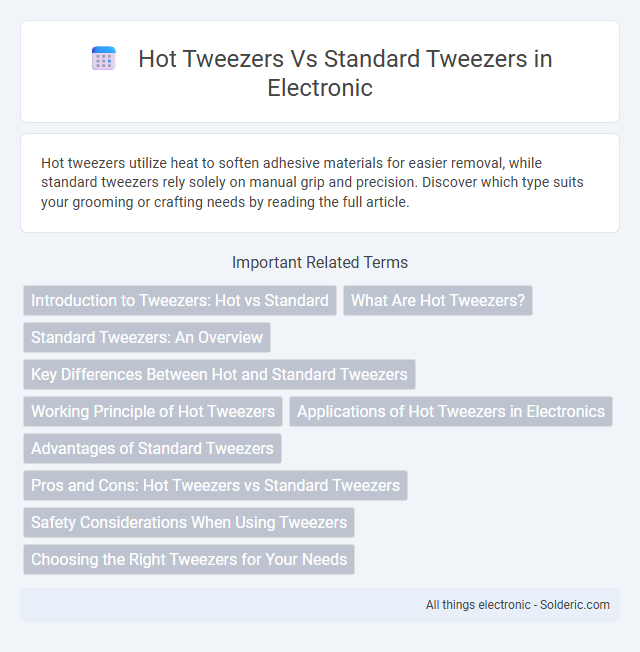Hot tweezers utilize heat to soften adhesive materials for easier removal, while standard tweezers rely solely on manual grip and precision. Discover which type suits your grooming or crafting needs by reading the full article.
Comparison Table
| Feature | Hot Tweezers | Standard Tweezers |
|---|---|---|
| Function | Heat and manipulate small electronic components | Grip and hold objects manually |
| Use Case | SMT soldering, PCB repair | General-purpose, cosmetic, crafts |
| Temperature Control | Integrated adjustable heating | None |
| Precision | High precision with heat application | High precision without heating |
| Material | Heat-resistant metals, insulated handles | Stainless steel or plastic |
| Price Range | Higher due to heating components | Lower, simple design |
| Safety | Requires caution due to heat | Safer, no heat involved |
Introduction to Tweezers: Hot vs Standard
Hot tweezers utilize controlled heat to seal or manipulate delicate materials, making them essential for electronics, skincare, and certain medical applications. Standard tweezers rely on manual pressure to grasp and remove small objects, offering precision for everyday tasks such as grooming, crafting, or first aid. Understanding the specific use cases and advantages of hot versus standard tweezers helps you select the right tool for your precision requirements.
What Are Hot Tweezers?
Hot tweezers are precision tools that use controlled heat to safely remove or reposition delicate components, commonly used in electronics for tasks like soldering or desoldering small parts. Unlike standard tweezers, which rely on manual gripping, hot tweezers combine heating elements with fine tips to melt solder quickly and reduce thermal damage. Their design improves efficiency and precision in handling tiny electronic elements such as SMD resistors, capacitors, and ICs.
Standard Tweezers: An Overview
Standard tweezers are precision tools commonly used for tasks requiring fine control, such as plucking hair, handling small electronic components, or applying eyelash extensions. They feature two arms joined at one end with flat, pointed, or angled tips designed to grasp tiny objects securely. Your choice of standard tweezers depends on the specific application, tip design, and material quality to ensure optimal performance and durability.
Key Differences Between Hot and Standard Tweezers
Hot tweezers use controlled heat to bond eyelash extensions through fusion, providing a seamless, long-lasting hold without adhesives, while standard tweezers rely on manual precision for picking and placing extensions. Hot tweezers feature temperature settings that help prevent damage to natural lashes by evenly distributing heat, whereas standard tweezers require skilled hand control to avoid pulling or breaking. The primary functional difference lies in the heat application for bonding in hot tweezers versus the purely mechanical grip of standard tweezers.
Working Principle of Hot Tweezers
Hot tweezers operate by applying controlled heat through two electrically heated tips that clamp onto delicate electronic components, enabling reflow soldering without direct contact with a soldering iron. This method melts solder precisely at the joint, allowing quick removal or placement of surface-mount devices (SMDs) with minimal thermal stress. Your use of hot tweezers ensures efficient handling of tiny components in PCB repair and assembly, outperforming standard tweezers which rely solely on mechanical grip without temperature control.
Applications of Hot Tweezers in Electronics
Hot tweezers are crucial in electronics for precise soldering and desoldering of surface-mount components, offering controlled heat application that prevents damage to sensitive circuit boards. Their ability to simultaneously heat both sides of a component ensures efficient rework and assembly processes in manufacturing and repair of devices like smartphones, computers, and PCBs. Compared to standard tweezers, hot tweezers enhance accuracy and reduce the risk of thermal stress-related failures in delicate electronic components.
Advantages of Standard Tweezers
Standard tweezers offer precise control for detailed tasks such as eyebrow shaping and splinter removal, making them ideal for personal grooming. Their straightforward design ensures durability and ease of sterilization, reducing the risk of infection during repeated use. You can rely on standard tweezers for steady grip and accurate handling without the need for power or heating elements.
Pros and Cons: Hot Tweezers vs Standard Tweezers
Hot tweezers offer precise heat application ideal for removing gel nail polish, reducing the need for acetone and minimizing damage to your natural nails, but they require careful handling to avoid burns and are generally more expensive. Standard tweezers provide versatile use for hair removal and small object handling with ease and affordability, yet they lack the specialized heating feature that enhances efficiency in certain beauty treatments. Choosing between hot and standard tweezers depends on your specific needs for precision, safety, and budget.
Safety Considerations When Using Tweezers
Hot tweezers pose unique safety risks due to their heated tips, increasing the potential for burns and skin damage, requiring careful temperature control and protective measures. Standard tweezers, while safer in terms of heat exposure, still demand cautious handling to avoid pinching or breaking skin, especially near sensitive areas like the eyes. Using proper techniques and tools designed for specific tasks can minimize injury risks associated with both hot and standard tweezers.
Choosing the Right Tweezers for Your Needs
Hot tweezers offer precise heat control ideal for eyelash extension application and delicate electronic repairs, providing enhanced grip and reducing the risk of damage compared to standard tweezers. Standard tweezers are versatile, easy to use, and suitable for general tasks like hair removal and picking up small objects, but they lack temperature precision and may not offer the same level of control for heat-sensitive applications. Selecting the right tweezers depends on your specific requirements, such as the need for temperature regulation, precision, and the type of materials you handle.
Hot tweezers vs standard tweezers Infographic

 solderic.com
solderic.com